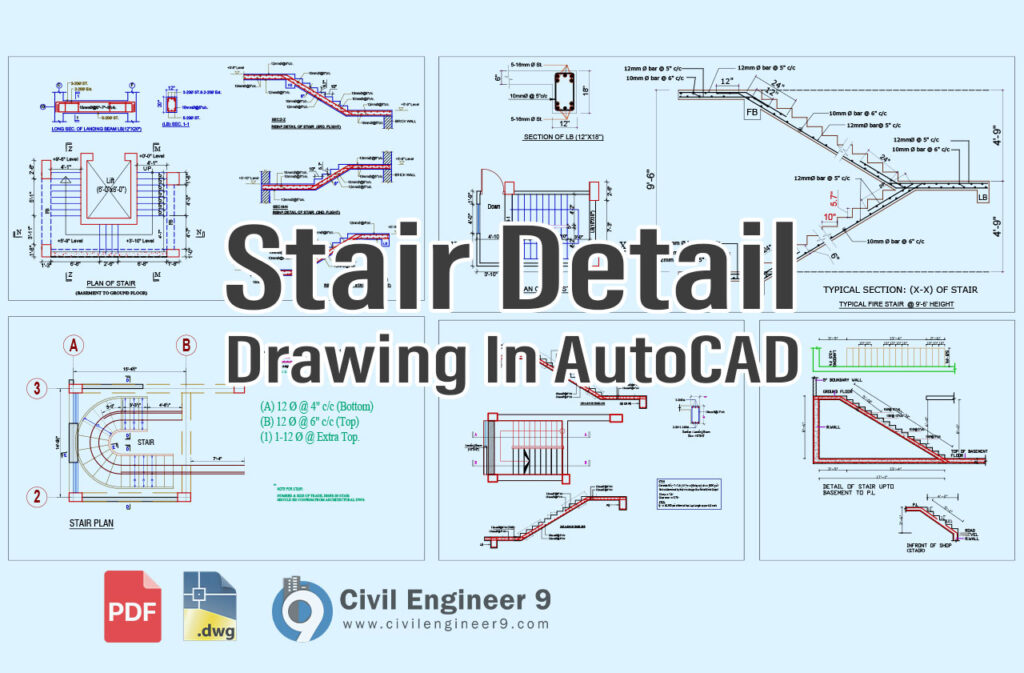In this article, we discuss stair detail drawing in the staircase different parts of steps, Tread, Riser, Rise, landing, Nosing, Going, Head Room, Handrail, Baluster, Balustrade, Pitch or Slope, Run, Soffit, Scotia, Newel-post, Strings Or Stringers, Waist, Line Of nosing, Walking Line, Spandrel.
Download: Architectural Drawing and Structural Drawing.
What is Staircase?
In architecture and construction, a staircase is a series of steps that connect different levels of a building or structure. Staircases can be made from a variety of materials, including wood, metal, stone, or concrete, and can take many different forms, such as straight, spiral, or curved. We will be discussed this article on concrete-made stairs.
Staircases can vary in complexity, from a simple set of steps leading from one level to another to more elaborate designs that incorporate landings, balustrades, handrails, and other decorative elements. The design of a staircase will depend on a number of factors, including the space available, the intended use of the stairs, and the architectural style of the building.
Parts of Concrete Stair Detail
In very important to know about the part of the staircase:
- Steps: The steps of a staircase are the individual horizontal treads that make up the staircase.
- Tread: The tread of a staircase is the horizontal part of a step that provides a flat surface to step on.
- Riser: The riser of a staircase is the vertical component of a step that connects the treads, or horizontal surfaces, of each step.
- Landing: A landing is a flat platform or area located between two flights of stairs in a staircase. It provides a resting point for users of the staircase and can also serve as a transitional space between different levels of a building.
- Run: The run of a staircase is the total horizontal distance covered by the staircase, from the first step at the bottom to the last step at the top.
- Head Room: The headroom of a staircase is the vertical distance between the finished floor level and the lowest point of the ceiling or any overhead obstruction above the staircase. It is the clearance or height of the space above the staircase, which allows users to stand upright and move safely and comfortably up and down the stairs.
Stair Detail Drawing In AutoCAD
Stair detail drawing refers to the process of designing and specifying the individual components that make up a staircase, including the treads, risers, stringers, handrails, and balusters. Detailed stair design is essential to ensure that the staircase is safe, functional, and aesthetically pleasing.
Important of Stair Detailing:
- The design of stair treads and risers is an important aspect of stair detailing, as it determines the safety and comfort of using the staircase.
- The detailing of a staircase involves a thorough understanding of the requirements of local building codes and regulations, as well as the specific needs of the building and its users.
- Handrails and balusters are also important components of stair detailing, as they provide safety and support for users of the staircase.
In addition to safety and functionality, stair detail drawing also involves considerations of aesthetics and style. Stairs can be designed in a variety of styles, from traditional to modern, and may feature decorative elements such as molding, lighting, or unique materials.
Here is the provided stair detail drawing in AutoCAD for architectural and structural design in DWG and PDF.
Stair Detail Drawing
Keyword:
- Stair Detail Drawing
- concrete stair detail
- staircase section detail drawing
- stair section detail
- spiral staircase cad block
- stairs in AutoCAD
- steel stair details
- wood stair details

